

Oak Island - Wikipedia, l'encyclopédie libre. Oak Island is a 57-hectare (140-acre) island in Lunenburg County on the south shore of Nova Scotia, Canada.
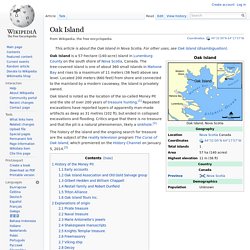
The tree-covered island is one of about 360 small islands in Mahone Bay and rises to a maximum of 11 meters (36 feet) above sea level. Located 200 meters (660 feet) from shore and connected to the mainland by a modern causeway, the island is privately owned. Oak Island is noted as the location of the so-called Money Pit and the site of over 200 years of treasure hunting.[1] Repeated excavations have reported layers of apparently man-made artifacts as deep as 31 metres (102 ft), but ended in collapsed excavations and flooding. Critics argue that there is no treasure and that the pit is a natural phenomenon, likely a sinkhole.[2]
Images - Oak Island Money Pit. Livre - Oak Island Money Pit. Oak Island - 1. Timeline 1795 - Daniel McGinnis finds The Money Pit.
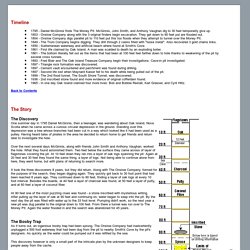
McGinnis, John Smith, and Anthony Vaughan dig to 30 feet temporarily give up. 1803 - Onslow Company along with the 3 original finders begin excavation. They get down to 90 feet put are flooded out. 1804 - Onslow Company digs parallel pit to 110 feet put this too floods when they attempt to tunnel over the Money Pit. 1849 - The Truro Company begins digging. They drill through 2 casks filled with "loose metal". Also recovered 3 gold chains links. 1850 - Subterranean waterway and artificial beach where found at Smith's Cove. 1861 - First life claimed by Oak Island. Back to Contents. Le mystère du puits de Oak Island - La terre, ses mystères, son histoire et plus encore.
Tout a commencé aux alentours de 1795 quand un jeune homme du nom de Daniel McGinnis s'aventura aux alentours de l'île de Oak Island, petite île canadienne dans Magone Bay en Nouvelle Ecosse.
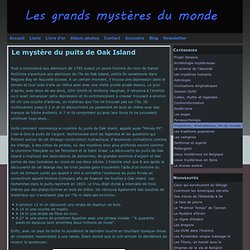
A un certain moment, il trouva une dépression dans le terrain et tout près d'elle un chêne avec avec une vieille poulie posée dessus. Le jour d'après, avec deux de ses amis, John Smith et Anthony Vaughan, il retourna à l'endroit où il avait remarquer cette dépression et ils commencèrent à creuser trouvant à environ 60 cm une couche d'ardoise, un matériau que l'on ne trouvait pas sur l'île. Ils continuèrent jusqu'à 3 m et ils découvrirent un pavement en bois de chêne avec des marque de hâche évidents. A 7 m ils comprirent qu'avec leur force ils ne pouvaient continuer tous seuls...
Oak Island Money Pit Trick. Treasure: Oak Island: The Money Pit. Chronology of the Oak Island Treasure Hunt (1909-1959) Oak Island - Le mystère de l'Île-aux-Chênes, selon Christian Page. Un dossier de Christian R.
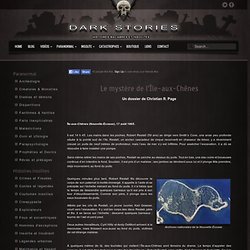
Page Île-aux-Chênes (Nouvelle-Écosse), 17 août 1965. Il est 14 h 45. Les mains dans les poches, Robert Restall (59 ans) se dirige vers Smith’s Cove, une anse peu profonde située à la pointe sud de l’île. Restall, un ancien cascadeur de cirque reconverti en chasseur de trésor, y a récemment creusé un puits de neuf mètres de profondeur, mais l’eau de mer s’y est infiltrée. Sans même retirer les mains de ses poches, Restall se penche au-dessus du puits. À quelques mètres de là, des touristes qui visitent l’Île-aux-Chênes sont témoins du drame. L’autopsie va révéler que les victimes sont mortes noyés. En ce mardi après-midi de 1965, la chasse au trésor de l’Île-aux-Chênes vient d’atteindre un nouveau sommet.
À l'été de 1795, Daniel McGinnis, un adolescent de 16 ans, décide d'explorer en solitaire l'Île-aux-Chênes : une terre minuscule et inhabitée longue d'à peine 1,500 mètres dans la baie de Mahone, à quelque 80 kilomètres au sud-ouest de Halifax (N. 1. The Secrets of Oak Island. Investigative Files Joe Nickell Volume 24.2, March / April 2000 It has been the focus of “the world's longest and most expensive treasure hunt” and “one of the world's deepest and most costly archaeological digs” (O'Connor 1988, 1, 4), as well as being “Canada's best-known mystery” (Colombo 1988, 33) and indeed one of “the great mysteries of the world.”

It may even “represent an ancient artifact created by a past civilization of advanced capability” (Crooker 1978, 7, 190). Oak Island Money Pit. The hunt for treasure on Oak Island has been going on for over two hundred years.

Without a single return, and conflicting theories of what hunters are actually looking for, the so-called Money Pit in Nova Scotia is one of the most incredible self-perpetuating goose chases in the world. In 1795, a teenager named Daniel McGinnis found an oval-shaped recession in the ground on the island. With little evidence that there was anything to be discovered, McGinnis started digging in the area and subsequently hit wooden planks every ten feet.
Film has unique view of Oak Island. The Treasure Pit of OAK ISLAND. If I told you that there was a buried treasure on an island just off the coast of Nova Scotia, you might believe me.
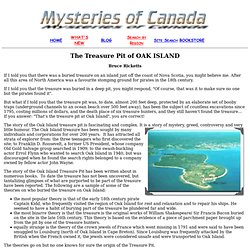
After all this area of North America was a favourite stomping ground for pirates in the 18th century. If I told you that the treasure was buried in a deep pit, you might respond, "Of course, that was it to make sure no one but the pirates found it". But what if I told you that the treasure pit was, to date, almost 200 feet deep, protected by an elaborate set of booby traps (underground channels to an ocean beach over 500 feet away), has been the subject of countless excavations since 1795, costing millions of dollars, and the death place of six treasure hunters, and they still haven’t found the treasure… If you answer: "That’s the treasure pit at Oak Island", you are correct!
The story of the Oak Island treasure pit is fascinating and complex. It is a story of mystery, greed, controversy and very little humour. Traps which were set to protect it. The Mystery of the Oak Island Money Pit. If you’ve never heard of the Oak Island treasure, or the legend of the Oak Island money pit just off the coast of Nova Scotia, then I have a treat for you.

This week I’ve decided to provide readers with a tour of this legendary island, and a little bit about both sides of the story that goes along with it. I say “both sides” because while there are many people that believe in and promote the original legend of this mysterious island, there are just as many people that point out the contradictory history of the island. The alternative story is just as fascinating as the original legend itself. The story that people have passed around about Oak Island is one that actually has different variations, depending upon who you talk to.
Oak Island Treasure. Oak Island. Oak Island Mystery. One can only wonder what would have happened if young Daniel McGinnis had chosen to go exploring somewhere else on that fateful day in the summer of 1795. If he had, perhaps nobody else would have walked the woods on the eastern end of Oak Island for the next ten years. In that time, the clearing McGinnis found might have been reclaimed completely by the woods.
In a forest, the thirteen foot-wide depression in the ground might never have been noticed. Thick, leafy branches might have obscured the old tackle block hanging from a branch directly over the pit. Without these markers, there would have been nothing to indicate that this was the work of man. Oak Island and The Money Pit. There are many beliefs as to what is buried there, but two claims have gained popularity among the "Money Pit" community.
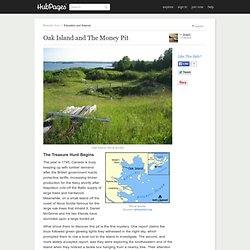
The first has to do with Captain Kidd's buried treasure. Nova Scotia Story: The Mystery of Oak Island. Do you believe in pirates and buried treasure?
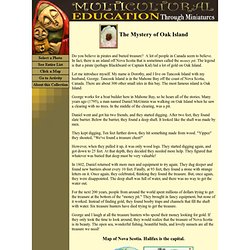
A lot of people in Canada seem to believe. Oak Island Money Pit : UnresolvedMysteries. Top Ten Money Pit Myths. The Top Ten Myths about the Money Pit 1) The Discovery of the Pit in 1795 is Historical Fact Wrong! While the story of "three boys on an adventure" finding the site in this year has been passed down by generations of poor researchers, no contemporary source documenting these events has ever been discovered. We do know that the men existed, but they were not boys.
McInnis was in his mid 30s, and the only historically documented "Anthony Vaughn" known to live in the area was of a similar age. Oak Island Money Pit - The Last Great Unsolved Mystery. Révélé: Le Secret de Oak Island. Mysterious Treasure on Oak Island. Why can’t they solve the mystery of Oak Island off the coast of Nova Scotia? By Marshall Brain | May 5, 2010 You Asked: Why can’t they solve the mystery of Oak Island off the coast of Nova Scotia?
— Chad, DesMoines, Iowa. Is the Ark of the Covenant Really Buried on a Small Canadian Island? Oak Island Mystery. Page Title. The Money Pit (Oak Island) Aliens Theory. Oak Island is noted as the location of the so-called Money Pit and the site of over 200 years of treasure hunting. Repeated excavations have reported layers of apparently man-made artifacts as deep as 31 meters, but ended in collapsed excavations and flooding. Critics argue that there is no treasure and that the pit is a natural phenomenon, likely a sinkhole. Wednesday Weird: Oak Island Money Pit. The money pit on Oak Island, Nova Scotia, is one of my favorite stories about possible buried treasure. Mostly because there have been so many excavations of the site and yet, still to this day, there is still conflict and mystery surrounding it. in 1795, an eighteen year old boy discovered a depression in the ground of oak island and a tackle block hanging from a tree adjacent.
So he convinced two of his friends to help excavate the hole. The Oak Island Money Pit. The Last Great Buried Treasure Mystery: The Money Pit at Oak Island. Treasure Hunted Says He's Solved The Oak Island Puzzle. Nouvelle théorie de Keith Ranville sur le Money Pit Oak Island. Keith Ranville - The man behind the theory This is a completely new theory on the Oak Island Money Pit mystery put forth by a Canadian man named Keith Ranville. When he first contacted me I almost deleted it thinking it was spam but after reading into it a little more he really caught my interest. He has since been keeping me posted with the latest news and there will surely be more to come so all I can give you is what I know so far.
Oak Island - Le Mystère de la Money Pit: fichiers de mystère. Daniel returned with two friends, John Smith aged 20 and Anthony Vaughan 13. Armed with picks and shovels they began to dig. The signs were promising. They discovered that they were digging down into a circular clay-lined shaft that clearly showed the marks of previous picks. At a depth of four feet, they discovered a layer of flag-stones. The stone was not native to Oak Island. At a depth of twenty feet they found another Oaken platform identical to the first, and at 30 feet, yet another! It was nine years later, in 1804, before they made their second attempt. The excavation resumed. The treasure seekers could not understand what the figures meant, and did not seem to think that they were significant. As nightfall fell, the diggers stopped work for the night, convinced that their treasure was only a few feet further down.
Despite bailing with buckets, and later a pump, they were not able to reduce the level of water. Oak Island Money Pit. A Rennes-le-Château recyclage - Page 3 - Canada - Portrait de la ville Forum. [QUOTE]The Inscribed Stone Sunday, 19 July 2009 14:38 | Author: Administrator | The time line for the money pit? S inscribed stone has never been completely identified in any single book. You might be surprised to learn of some details, especially of quickly unfolding series of suspicious events which happened during the 1860s. The implied historic time line which takes us to 1864 is the following: AHOY PIRATES! - A LECTURE BY JOHN HORRIGAN. Description: For centuries piracy has impacted national economies as privateers and pirates (some commissioned clandestinely by governments and monarchies) brutally preyed upon defenseless cargo ships and then absconded with their plunder. Some of these treasures were never recovered.
The Money Pit.